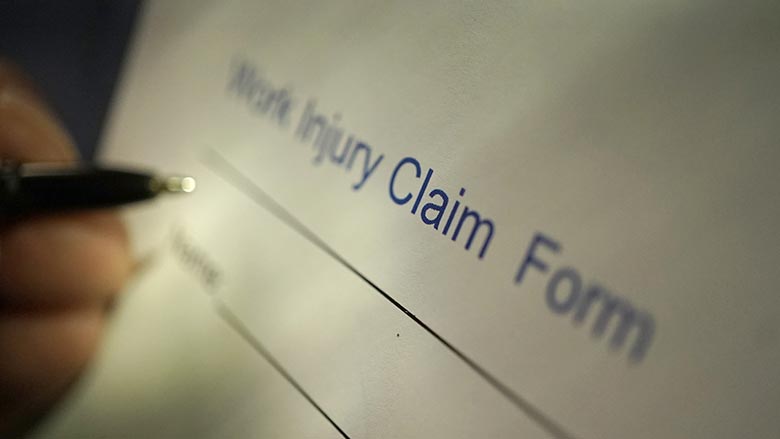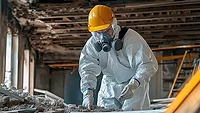OSHA Recordkeeping and Reporting for Restoration Companies

Photo credit: Rudzhan Nagiev / iStock / Getty Images Plus via Getty Images
Throughout my travels it has been common for me to find a Restoration Company not posting an OSHA 300 Log. In the big picture of safety, this certainly is not a huge issue – posting a 300 Log does not make you safer! However, I believe this topic falls into the category of “Cracking the Door Open”.
Let me explain. Envision a Restoration Company that somehow ends up with an OSHA Inspection in their office or warehouse. The inspector begins looking deeper and further for infractions and notices there isn’t a 300 Log posted. I consider this a door cracked open that leads to further questions and investigation into how injuries are managed, recorded, etc.
In this article I’m going to give you an overview of the OSHA’s recordkeeping and reporting requirements and how you can keep that door from being cracked open.
What is Recordkeeping and Reporting?
This is quite simple:
- Recordkeeping is maintaining an OSHA 300 log that documents details of employee injuries and illnesses.
- Reporting is informing OSHA of specific types of injuries within certain timeframes.

Photo credit: ProfessionalStudioImages / iStock / Getty Images Plus via Getty Images
What OSHA Expects
OSHA Part 1904 lays out the requirements for recordkeeping and reporting. (1) Some Restoration Companies will meet the requirements and others won’t. There are two exemptions that sort this out. The first exemption is for companies with ten or fewer employees; they will not need to maintain an OSHA 300 Log. See the following section on exemptions for more details.
The second exemption is for companies working in a low-hazard industry. To understand the industry hazard level, the company will need to determine it’s SIC or NAICS Code. I have always used the NAICS Code, so I’m going to cover that. Please see the next section for details.
If your company does not meet either of these two exemptions, OSHA expects you to maintain and post a 300 Log.
NAICS Codes and the Restoration Industry
The acronym NAICS stands for North American Industry Classification System. The system has 6-digit numerical codes for different types of businesses (e.g. roofing, auto dealers and bakeries). A company picks their NAICS Code; nobody assigns it to you.
Restoration Businesses do not have their own NAICS Code. Instead, we must fit ourselves into a relatively similar industry. The most commonly used code I have seen is 236220. This code is for “Commercial and Institutional Building Construction” and further expands into “Addition, alteration and renovation, commercial and institutional building”.
(2) I give you this information only as a reference; your interpretation may differ and I encourage you to research if other codes make more sense for your company.
You can get help determining your Code through the NAICS website and their NAICS Lookup Help page. (3)
OSHA 300 Log
The 300 Log is a three-part form that can be a handwritten hard copy, a fillable PDF form, or an Excel spreadsheet. The three parts are as follows:
- Form 300: this part identifies the employee, describes the injury/illness case, and classifies it.
- Form 300A: this is the part that summarizes your cases over the course of the year and is posted the following February 1st through May 1st. It contains your company information, NAICS Code, number of employees, total employee work hours, and the signature of a company executive.
- Form 301: this part contains the incident report for each reported case. It contains details about the employee, the treating physician, and what specifically happened.
Please see the Resources Section to get downloadable 300 Logs and instructions.

Photo credit: Kameleon007 / iStock / Getty Images Plus via Getty Images
Recordable Injuries
It is important to understand that only “recordable” injuries and illnesses are entered into the 300 Log. Here are some examples of recordable injuries (4):
- Stitches
- Broken bones
- Passing out
- Doctor-prescribed medication
- Doctor ordered days away from work
- Doctor ordered restricted/limited work duty
Here are some examples of non-recordable injuries (5):
- Minor injuries treated with First Aid (e.g. abrasions, scratches)
- Butterfly bandage, Band-Aids, or Steri-Strips applied to a cut
- Taking nonprescription medication
- Tetanus shots
- Hot or cold therapy
- Drilling a fingernail or toenail to relieve pressure
- Splinter removal
- Removal of foreign bodies from the eye with only irrigation or cotton swab
Notes:
- See the Resources Section to help determine what is recordable.
- States that have their own OSHA Program generally have a specific 300 Log (e.g. Michigan and California). Check with your State to see if you need to use their form.
Exemptions
Let me repeat how a company can be exempted from maintaining a 300 Log. Your company has to meet one of these criteria to be exempt (6):
- You have 10 or less employees at all times throughout the previous year. The key qualifier is “…at all times…” That means if you had 11 employees for three months and then dropped back to 10 employees, you are not exempt.
- Your NAICS Code is considered a low-hazard industry. See the Fact Sheet in (6) of the References Section to verify this.
Warning: I have not seen an NAICS Code in the exemption list that would fit the Restoration Industry. As previously mentioned, we are lumped in with the Construction Industry and therefore considered a high-risk industry.
Maintaining and Posting a Log
Finally, we arrive at companies who qualify for maintaining a 300 Log. Maintaining is simply recording information when you have a recordable injury. Be sure to complete pages 1 and 3 of the 300 Log collection.
Posting involves completing all the information on the 300A form. On the left side of the form, you total everything recorded on the 300 Form (first page) onto the 300A (second page). On the right side of the form, you will need complete your company information, the average number of employees throughout the previous year, and the total labor hours worked by those employees. Finally, a company executive will need to sign and date the form.
At this point, you are ready to post. Every year, 300A Logs are to be posted on February 1 and remain posted until April 30. On May 1, you can remove the posting. Be sure to post in a common area where employees can see it, like a break room or common hallway.
Electronic Submission of Records
Some employers will be required to take the additional step of electronically submitting their 300 Log to OSHA. Here is OSHA’s list of exemptions for electronic reporting; if you meet any of these criteria then you don’t have to report (7):
- The establishment's peak employment during the previous calendar year was 19 or fewer, regardless of the establishment's industry.
- The establishment's industry is on Appendix A to Subpart B of OSHA’s recordkeeping regulation, regardless of the size of the establishment.
- The establishment had a peak employment between 20 and 249 employees during the previous calendar year AND the establishment's industry is NOT on Appendix A to Subpart E of OSHA’s recordkeeping regulation.
For the sake of keeping this article relatively short, please refer to (7) in the references section for further details.

Photo credit: izzetugutmen / iStock / Getty Images Plus via Getty Images
OSHA Severe Injury Reporting
This reporting requirement is completely separate from the OSHA 300 Log!
OSHA expects any employer to report the following injuries (8):
- All employers are required to notify OSHA when an employee is killed on the job or suffers a work-related hospitalization, amputation, or loss of an eye.
- A fatality must be reported within 8 hours.
- An in-patient hospitalization, amputation, or eye loss must be reported within 24 hours.
Please refer to (8) in the references section for details.
When I started writing this article, I thought it would be simple and straight-forward. Then I got into the details and realized how complicated it can be! Further, I have barely scratched the surface on other details. Please reach out to a Safety Professional, an OSHA Office, or attend a workshop in your State to verify you understand what’s expected of you and get all your questions answered.
I stand by my statement that if your company is inspected by OSHA, this is a topic that can crack open the door to many other questions and potential violations. I strongly recommend Restoration Companies evaluate if they qualify for maintaining an OSHA 300 log and understand when you should report serious injuries.
Resources
OSHA 300 Logs:
Occupational Safety and Health Administration, Injury & Illness Recordkeeping Forms – 300, 300A, 301. https://www.osha.gov/recordkeeping/forms
Determining a Recordable Injury:
Occupational Safety and Health Administration, OSHA Forms for Recording Work-Related Injuries and Illnesses, Page 2, An Overview: Recording Work-related Injuries and Illnesses. https://www.osha.gov/sites/default/files/OSHA-RK-Forms-Package.pdf
Occupational Safety and Health Administration, Recording and Reporting Occupational Injuries and Illnesses, 1904.7. https://www.osha.gov/laws-regs/regulations/standardnumber/1904/1904.7
Occupational Safety and Health Administration, OSHA Injury and Illness Recordkeeping and Reporting Requirements. https://www.osha.gov/recordkeeping
OSHA National New Release, Department of Labor announces rule expanding submission requirements for injury, illness date provided by employers in high-hazard industries, July 17, 2023. https://www.osha.gov/news/newsreleases/national/07172023
References
- Occupational Safety and Health Administration, Regulations, Standard Number 1904, Recording and Reporting Occupational Injuries and Illnesses. https://www.osha.gov/laws-regs/regulations/standardnumber/1904/
- United States Census Bureau, North American Industry Classification System, 2022 NAICS Definition, 236220 Commercial and Institutional Building Construction. https://www.census.gov/naics/?input=236220&year=2022&details=236220
- North American Industry Classification System, NAICS Lookup Help. https://www.naics.com/naics-identification-help/
- Occupational Safety and Health Administration, Regulations, Standard Number 1904, Recording and Reporting Occupational Injuries and Illnesses, 1904.7(a). https://www.osha.gov/laws-regs/regulations/standardnumber/1904/1904.7#:~:text=Basic%20requirement.,aid%2C%20or%20loss%20of%20consciousness.
- Occupational Safety and Health Administration, Regulations, Standard Number 1904, Recording and Reporting Occupational Injuries and Illnesses, 1904.7(b)(5)(ii). https://www.osha.gov/laws-regs/regulations/standardnumber/1904/1904.7
- Occupational Safety and Health Administration, OSHA Fact Sheet, Updates to OSHA’s Recordkeeping Rule: Who is Required to Keep Records and Who is Exempt, DEA FS-3746, 09/2014. https://www.osha.gov/sites/default/files/publications/OSHA3746.pdf
- Occupational Safety and Health Administration, Injury Tracking Application (ITA). https://www.osha.gov/injuryreporting
- Occupational Safety and Health Administration, Report a Fatality or Severe Injury. https://www.osha.gov/report/
Looking for a reprint of this article?
From high-res PDFs to custom plaques, order your copy today!








